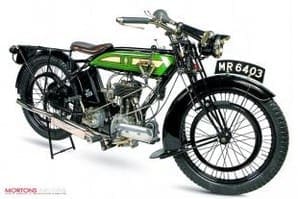
Owner and restorer of this side-valve BSA is Swindon enthusiast Alan Smith, who actually provided the first motorcycle we featured in this Spotlight series, his 2006 Stafford best in show 1928 AJS K7, which featured in the September 2006 issue. This side-valve BSA is pretty much from the opposite end of the vintage spectrum to the sporty AJS, being a big, hefty long-stroke single cylinder bike built not for performance or pose, simply honest endeavour.
Indeed, it’s the embodiment of what made BSA famous in the 1920s, ticking the boxes for being solid, rugged and dependable. Though perhaps not the most exciting – remember, BSA had its fingers badly burned when it tried to ‘go exciting’ at the 1921 TT, with all the hideously expensively (reputedly £10,000) assembled, specially built racers failing one after another – by the period this model was built, BSA had decided to stick to doing what it knew best. That was motorcycles aimed squarely at and predominantly for the man in the street and a long-stroke side-valve single was exactly that.
Enjoy more Classic MotorCycle reading in the monthly magazine.
Click here to subscribe & save.
 One in four is a BSA
One in four is a BSA
During the 1920s, BSA became the company able to justifiably boast ‘one in four is a BSA’ and claim that BSAs were ‘The most popular motorcycle in the world.’ Much of that was due to the 1924 introduced Model B (Round Tank) of which it and its replacement, the Wedge Tank, 35,000 examples were sold in approximately four years.
The side-valve long-range 500cc BSA was renowned for its low down torque; indeed, operating the outward-opening lever throttle in tandem with the air lever, means models like this plod along regally, gathering speed in a manner which puts to shame the finicky nature of much more modern machines. BSA was by nature a conservative company, staying with the dummy belt rim brakes until 1925, the year of this model, while lubrication was of the constant loss type.
BSA was to go and come up with some more exciting models (including the rather fabulous 350cc ohv model and of course the world renowned Sloper) in the next couple of years, while the 1930s was to bring the range of attractive ohv V-twins and ever-more sporting singles, culminating in the famous 1938 Gold Star. But it was models like this one, dependable and solid, which laid the bedrock for the more glamorous brethren. ![]()
Advert
 Enjoy more The Classic MotorCycle reading in the monthly magazine. Click here to subscribe.
Enjoy more The Classic MotorCycle reading in the monthly magazine. Click here to subscribe.



